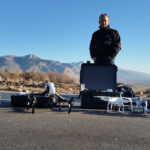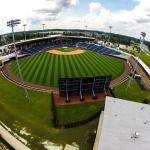Here at the University of Utah Department of Mechanical Engineering, a group of graduate students led by Dr. Kam K. Leang have been working in a research team dubbed the DARC (Design, Automation, Robotics & Control) Laboratory. There, the team works on design for remotely controlled aircraft and development of intelligent autonomous systems intended to improve navigation and safety when piloting drones. More information about the DARC Lab, including videos of their intelligent flight systems and numerous publications on the engineering behind robotics, can be found here.
I recently had the opportunity to visit their lab and look at some of their projects, including their advanced indoor navigation systems. Daman Bareiss, a graduate student working on his Ph.D. in Mechanical Engineering, agreed to answer a few questions about the research they are performing.
David Abueg: At my visit to the DARC lab, it was mentioned that one of your goals is to make flying drones significantly easier than how they operate now. What methods are you working on to accomplish this?
Damon Bareiss: Currently, I am using methods of predictive collision avoidance. There are a few main classes of algorithms developed to keep mobile robots from crashing into things. There is the global planning method where you can estimate where the obstacles are and plan an entire path through the environment. I personally think this isn’t great for real-world applications because of the need for knowledge of the entire environment which is very difficult to obtain. There are reactive methods that as an object approaches, the robot responds appropriately. Then there are predictive methods which is where I work. These are somewhat of a middle-ground between the two other approaches. My methods take some known parameters of the robot to estimate how it will move, and then that path can be checked for any potential collisions. If there is one, we intelligently override the original path the robot would take such that it does not avoid collisions. How to override the input is where the majority of the research is done. I work on methods that can be both teleoperated or fully autonomous. My research is developing small modules that can be “plugged into” a bigger system and gives the capability of avoiding collisions.
Abueg: Have there been any conflicts with the FAA in regards to your research here at the DARC lab?
Bareiss: We currently have not had any conflicts or work with the FAA. Our work for now is focusing on smaller scale vehicles for indoor operations. However, we are anticipating some of the work to expand to larger, outdoor drones. If this does happen, we will likely work directly with a company who already manufactures larger drones and has a working relationship with the FAA regarding the regulations their drones must meet.
Dr. Kam Leang: We are also in the process of getting FAA approval to fly other platforms outdoors. We fully comply with all FAA regulations.
Abueg: What is your ultimate vision of drones in the future? Do you think that they will remain remote operated, or would you like to have drones operate autonomously utilizing sensors and GPS?
Bareiss: I think we will have both. There will always be situations where a person needs to be in the loop. My favorite example for my current work is search and rescue. It will always be a major challenge to try and give a robot enough information to make intelligent decisions when it comes to searching for people who are, for example, lost in the forest. However, many people are already trained in this and are very good at doing their jobs. Giving them drones that could be (easily) remotely operated could allow them to have better vantage points, i.e. in the air, with cheaper, more maneuverable devices like a drone. The alternative is flying in a helicopter which is more expensive and a more drastic measure. There will be a need for fully autonomous as well and I believe the technology will reach the point where we can do so someday. The main benefit I feel of fully autonomous is the fact that we don’t need to maintain a communication link which is a difficult task in some environments for remotely operated vehicles.




